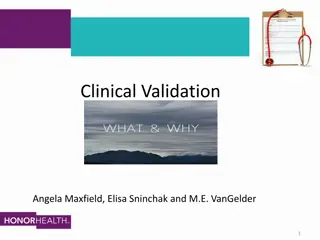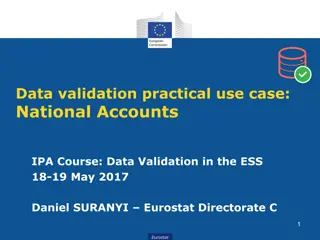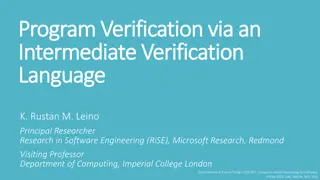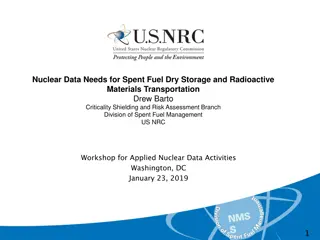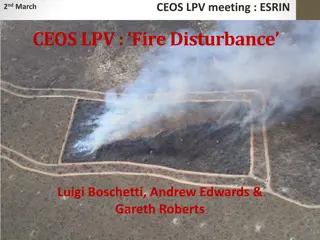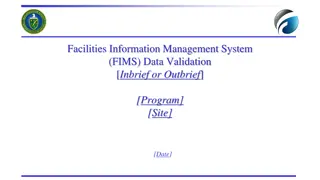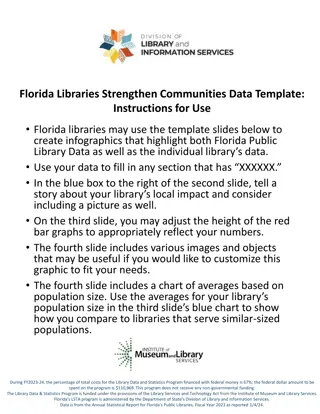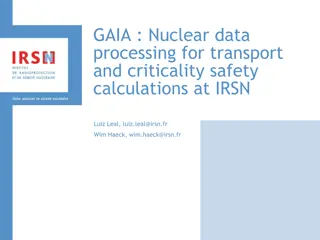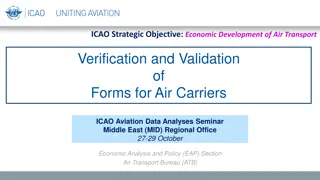Verification and Validation of FISPACT-II & General-Purpose Nuclear Data Libraries
The paper discusses the verification and validation of FISPACT-II and general-purpose nuclear data libraries presented at the UK National Conference on Applied Radiation Metrology. It covers new features of FISPACT-II, fusion decay heat experiments, uncertainty quantification, collaboration opportunities, and continuous development from 2011 to present. The FISPACT-II code offers advanced nuclear observables and data processing capabilities for a wide range of applications, including fine grid data, variance-covariance treatment, self-shielding mechanisms, multi-irradiation analysis, and more. The latest release includes enhancements such as power density normalization, energy-dependent fission yield collapse, and temperature-dependent plasma reaction rate calculations. The discussion also touches upon fission pulse decay heat simulations involving various nuclides to capture heat output values and half-lives accurately.
Download Presentation

Please find below an Image/Link to download the presentation.
The content on the website is provided AS IS for your information and personal use only. It may not be sold, licensed, or shared on other websites without obtaining consent from the author.If you encounter any issues during the download, it is possible that the publisher has removed the file from their server.
You are allowed to download the files provided on this website for personal or commercial use, subject to the condition that they are used lawfully. All files are the property of their respective owners.
The content on the website is provided AS IS for your information and personal use only. It may not be sold, licensed, or shared on other websites without obtaining consent from the author.
E N D
Presentation Transcript
Verification and Validation of FISPACT-II & General-Purpose Nuclear Data Libraries M. Fleming, J-Ch. Sublet, M. Gilbert, J. Kopecky1, A. Koning2, D. Rochman3 1JUKO Research 2IAEA Nuclear Data Section 3Paul Scherrer Institut UK National Conference on Applied Radiation Metrology NPL, Teddington, UK 11 November 2015 1
Overview 1. Summary of new FISPACT-II code features, data libraries 2. Comments on fission decay heat measurements & simulations 3. Results from FISPACT-II V&V on fission pulse decay heat 4. Fusion decay heat experiments and validation 5. Uncertainty quantification and propagation by coupling technological nuclear data generation (TENDL and GEFY) with FISPACT-II 6. Proposed areas for collaboration 2
Snapshot of FISPACT-II FISPACT-II has been developed by UKAEA to provide nuclear observables, using the most advanced nuclear reaction physics, for a wide variety of applications Some features: Fine grid data for 5 incident particles, nFY, sFY, oFY, any major DD All ENDF-6 data including full processing of TENDL-2014 Full variance-covariance treatment Modern LSODES-2003 solver Resolved and unresolved self-shielding through PTs DPA, kerma, PKA, gas production, yields up to GeV Monte-carlo sensitivity analysis Multi-irradiation/cooling step pathway analysis Thin/thick target yields Temperatures from 0K to 1200K, and above to kT=5, 30, 100 keV 3
Some new features in 3-00 Continuous development from 2011-present. Release follows 2-20- 10 release of June 2014. New release contains more features: POWER density normalisation to complete kerma for all reactions (allows normalisation for reactor simulations) Energy-dependent fission yield collapse (more than 40 incident energies) using GEFY n- g- p- d- a- FY Multiple-particle, simultaneous irradiations Emitted spectra for primary knock-on atoms (PKAs) for all reaction products Temperature-dependent plasma reaction rate calculations (fusion, stellar nucleosynthesis, etc.) Improved pathway routines, tolerances, covariance processing, visualisation methods, data outputs and more Bug-fixes, responses to user requests, etc. 4
Fission pulse decay heat 1E+04 Heat Output (kW/kg) value/t-half for nuclide 1E+03 While burn-up codes handle a small sub-set, many nuclides must be tracked to simulate decay heat 97Sr 97nY 96Sr 97mY 95Rb 1E+02 142Cs 98mY 98Y 99Y 99Zr 103Nb 102mNb101Zr 92Kr 92Rb 141Xe 98Sr 143Cs 93Rb 100Y 94Rb 93Kr 100mY 104mNb 145Ba 91Kr 102Zr 102Nb 97Y 89Br 100Zr 138I 96mY 95Sr 143Ba 140Xe 144Ba 1E+01 101Nb 96Y 135Te 141Cs 88Br 146mLa 146La 137I 136Te 145La 90Kr 139Xe 100Nb 86Se 136mI 140Cs Heat Output (kW/kg) 91Rb 94Sr 87Br 85Se 144La 98Zr 1E+00 86Br 89Kr 136I 133Sb 147Ce 103Mo 99Nb 132Sb 137Xe 93Sr 90mRb 132mSb 138Xe 95Y 98Nb 142Ba 139Cs 1E-01 133Te 141Ba 134Te 131Sb 89Rb 143La 101Mo 130mSb 90Rb 133mTe 134I 145Ce 102Tc 99mNb 94Y 105Tc 1E-02 103Tc 130Sb 138Cs 88Kr 92Sr 148Pr 104Tc 135I 87Kr 88Rb 131Te 1E-03 147Pr 142La 84Br 97mNb 97Zr The integral quantity hides a great deal which can be very questionable (see later) 91Sr 139Ba 146Pr 1E-04 132I 129Sb 131mTe 133I 132Te 97Nb 135Xe 92Y 141La 1E-05 93Y 101Tc 140Ba 91mY 1E-06 1E-01 1E+00 1E+01 1E+02 Time after irradiation (s) 1E+03 1E+04 1E+05 1E+06 1E+04 Heat Output (kW/kg) Greenwood WPEC SG 25 P1 WPEC SG 25 P2 WPEC SG 25 P3 1E+03 97Sr Many nuclides have (or had) poorly explored decay schemes. Some fixed by international effort on TAGS, fewer implemented, particularly in JEFF-3.1.1 (3.2?) decay data 1E+02 142Cs 99Zr 92Rb 93Rb 145Ba 102Nb 95Sr 141Cs 145La 143Ba 88Br 140Xe 144Ba 1E+01 96Y 101Nb 100Nb 137I 90Kr 136mI 139Xe Heat Output (kW/kg) 91Rb 140Cs 147Ce 103Mo 94Sr 136I 87Br 144La 1E+00 86Br 89Kr 137Xe 99Nb 132Sb 93Sr 142Ba 98Nb 90mRb 1E-01 95Y 139Cs 90Rb 145Ce 141Ba 89Rb 143La 104Tc 102Tc 94Y 105Tc 103Tc 1E-02 148Pr 138Cs 1E-03 147Pr 142La 146Pr 1E-04 1E-05 1E-06 1E-01 1E+00 1E+01 1E+02 Time after irradiation (s) 1E+03 1E+04 1E+05 1E+06 5
More warnings There is no pulse experiment for decay heat, but many different finite irradiations Right: ORNL Dickens 241Pu data from 1-1000 s irradiations To get to pulse, correct using C(pulse)/C(finite) Stitch together for results 1.6 100 ms Irradiation 1 s Irradiation 10 s Irradiation 100 s Irradiation 1000 s Irradiation Burst Function Dickens total 1.4 1.2 1 Decay heat (MeV/fission) 0.8 0.6 There is no Tobias experiment Tobias is statistical analysis of pre-1989 data (no Lowell etc.) Many similar experiments had systematic faults -> Tobias Stitching of multiple irradiations, spectra, etc. gives Frankenstein 0.4 0.2 0 1 10 100 1000 10000 100000 Time (s) 241Pu DH pulse with typical method of displaying as MeV/fission * cooling time 6
Standard pulse simulations 1.4 1.6 1.6 ENDF/B-7.1 nFY+DD JENDL-4.0 nFY+DD JEFF-3.1.1 nFY+DD GEF-4.2+UKDD-12 ENDF/B-7.1 nFY+DD JENDL-4.0 nFY+DD JEFF-3.1.1 nFY+DD GEF-4.2+UKDD-12 ENDF/B-7.1 nFY+DD JENDL-4.0 nFY+DD JEFF-3.1.1 nFY+DD GEF-4.2+UKDD-12 1.4 1.4 1.2 Tobias Dickens Lowell Tobias Dickens Lowell Dickens 1.2 1.2 1 Decay heat (MeV/fission) Decay heat (MeV/fission) Decay heat (MeV/fission) 1 1 0.8 0.8 0.8 0.6 0.6 0.6 0.4 0.4 0.4 0.2 0.2 0.2 0 0 0 0.1 1 10 100 Time (s) 1000 10000 100000 0.1 1 10 100 Time (s) 1000 10000 100000 1 10 100 1000 10000 Time (s) Top (left to right): thermal U5, P9, P1 total and gamma heat Bottom (left to right): fast U3, U8, P9 total and gamma heat Note Pandemonium still in JEFF-3.1.1 and UKAEA DD-12 for gamma 1.2 1.2 2.5 ENDF/B-7.1 nFY+DD JENDL-4.0 nFY+DD JEFF-3.1.1 nFY+DD GEF-4.2+UKDD-12 ENDF/B-7.1 nFY+DD JENDL-4.0 nFY+DD JEFF-3.1.1 nFY+DD GEF-4.2+UKDD-12 ENDF/B-7.1 nFY+DD JENDL-4.0 nFY+DD JEFF-3.1.1 nFY+DD GEF-4.2+UKDD-12 Akiyama Akiyama Akiyama Lowell 1 1 2 0.8 0.8 Decay heat (MeV/fission) Decay heat (MeV/fission) Decay heat (MeV/fission) 1.5 0.6 0.6 1 0.4 0.4 0.5 0.2 0.2 0 0 0 10 100 1000 10000 10 100 1000 10000 0.1 1 10 100 1000 10000 Time (s) Time (s) Time (s) 7
Non-pulse simulations 1E+01 1.0E+01 1 ENDF/B-7.1 nFY+DD JENDL-4.0 nFY+DD JEFF-3.1.1 nFY+DD GEF-4.2 nFY+UKDD-12 ENDF/B-7.1 nFY+DD JENDL-4.0 nFY+DD JEFF-3.1.1 nFY+DD GEF-4.2 nFY+UKDD-12 ENDF/B-7.1 nFY+DD JENDL-4.0 nFY+DD JEFF-3.1.1 nFY+DD GEF-4.2+UKDD-12 Fisher gamma Murphy beta McNair total 1E+00 1.0E+00 Gamma decay heat (MeV/fission) Beta decay heat (MeV/fission) Beta decay heat (MeV/fission) 1E-01 1E-02 0.1 1.0E-01 104 s 105 s 1E-03 10s 100s 1000s 1.0E-02 1E-04 1E-05 0.01 1x106 1x107 1x108 10 100 1000 10000 100000 10 100 1000 Time (s) 10000 100000 0.1 1 10 100 Time (s) Time (s) Top (left to right): ZEBRA long P9, HERALD P9, GODIVA-II Th232 Bottom (left to right): LANL U5 LHBoC, Studsvik U5 beta, CEA U5 calor As with pulse, these are a small subset of those in CCFE-R(15)28 10 9.0E-01 1.0E+01 ENDF/B-7.1 nFY+DD JENDL-4.0 nFY+DD JEFF-3.1.1 nFY+DD GEF-4.2 nFY+UKDD-12 ENDF/B-7.1 nFY+DD JENDL-4.0 nFY+DD JEFF-3.1.1 nFY+DD GEF-4.2 nFY+UKDD-12 Johannson 4s beta Johannson 10s beta Johannson 120s beta 9 8.0E-01 Lott total 8 7.0E-01 7 Total decay heat (MeV/fission) Total decay heat (MeV/fission) Beta decay heat (MeV/fission) 1.0E+00 6 6.0E-01 5 x3 x30 5.0E-01 4 1.0E-01 100s 1000s 5000s 3 4.0E-01 2 ENDF/B-7.1 nFY+DD JENDL-4.0 nFY+DD JEFF-3.1.1 nFY+DD GEF-4.2 nFY+UKDD-12 3.0E-01 1 Yarnell total 1.0E-02 0 2.0E-01 100 1000 10000 100000 10 100 1000 Time (s) 10000 100000 10 100 1000 10000 Time (s) Time (s) 8
Probe the data: DD Pu239 Dominant Beta Heat Nuclides at 100s 4.5E-01 ENDF/B-7.1 JENDL-4.0 JEFF-3.1.1 UKDD-12 8 Fix the nFY (all JEFF-3.1.1 for example) and vary the decay data to probe for differences 4.0E-01 4 3.5E-01 Ratio against ENDF/B-7.1 3.0E-01 2 Beta heat (kW) 2.5E-01 1 2.0E-01 0.5 Right: 239Pu beta (top) and gamma (bottom) heat at 100 s cooling note large variation in decay files Nominal values and ratio to one, here ENDF/B-VII.1 1.5E-01 1.0E-01 0.25 5.0E-02 0.125 0.0E+00 Cs140 Mo103 Nb98 Tc103 Xe137 Xe139 Tc106 Mo104 La144 I136 Mo105 Pu239 Dominant Gamma Heat Nuclides at 100s Rb91 Sr94 Tc102 Sr95 Zr98 Cs139 Cs141 Rb90 Ru107 Rh108 I137 Rh109 Y95 Br86 Kr89 Tc105 Ce147 Ce145 Te135 Pr148 Kr90 Sb132 La143 Ru109 Br87 Tc107 Sr93 La145 Nb99 Y94 Ce148 Pr149 Ba141 Xe138 Sb133 Mo101 I136m Nb99m Sn130m 6.0E-01 ENDF/B-7.1 JENDL-4.0 JEFF-3.1.1 UKDD-12 8 5.0E-01 4 Ratio against ENDF/B-7.1 4.0E-01 2 Gamma heat (kW) Useful check to see what evaluations have been performed and where some libraries lag behind (or make different evaluations) 3.0E-01 1 0.5 2.0E-01 0.25 1.0E-01 0.125 0.0E+00 I136m Rh110m Sb132m Rb90m Nb99m Sb130m Sn130m Sn131m La144 Tc106 Cs140 Mo105 Mo103 Rb91 Sr94 I136 Tc105 Sr93 Xe139 Ce147 La145 Cs141 Rb90 Sr95 Br86 Sb132 Tc104 Sb133 Br87 Ce145 Tc103 Kr89 Pr148 Mo101 Ru109 Zr98 Y95 Tc107 Pr149 Nb98 Ba142 Kr90 I137 Xe138 Mo104 Ba141 Xe137 Ru107 Ce148 Sb131 9
Probe the data: nFY U233 Dominant Beta Heat Nuclides at 10s 2.5E-02 JEFF-3.1.1 ENDF/B-7.1 JENDL-4.0 GEF-4.2 Other option: use the same DD and vary the nFY 8 4 2.0E-02 Ratio against JEFF-3.1.1 2 Beta heat (kW) 1.5E-02 Right: 233U fast fission pulse beta (top) and gamma (bottom) at 10 s cooling Nominal values and ratio to an example, here JEFF-3.1.1 1 1.0E-02 0.5 5.0E-03 0.25 0.125 0.0E+00 Y96m I136m Nb100m La146m Y98m Rb92 Y96 Nb100 Nb101 Rb93 Kr91 Nb98 Sr95 Zr100 Br88 Nb99 Zr99 Nb102 Ba143 Br89 Kr90 Cs141 Y97 Cs140 Rb91 Zr98 Se87 Br87 I137 Xe139 Te135 Rb94 Ba144 La144 Zr101 Se86 I138 Se85 La145 Br86 Sr94 La146 Xe140 Kr89 Pr150 La147 As83 Cs142 Xe137 Zr102 U233 Dominant Gamma Heat Nuclides at 10s 1.2E-02 JEFF-3.1.1 ENDF/B-7.1 JENDL-4.0 GEF-4.2 8 This is all over the place! Note that the same DD is used in each simulation, but varied independent fission yields 1.0E-02 4 Ratio against JEFF-3.1.1 8.0E-03 2 Gamma heat (kW) 6.0E-03 1 0.5 4.0E-03 Minor actinides all show the same pattern 0.25 2.0E-03 0.125 0.0E+00 Y96m Nb100m Y98m I136m La146m Sn128m I133m As82m Rb90m Rb92 Rb93 Br88 La144 Sr95 Rb91 Ba143 Kr91 Br87 Cs141 La145 Nb102 Nb100 Kr90 Se86 Br89 Cs140 Br86 Sr94 Y97 Zr99 Rb94 Se85 Ba144 Zr98 As83 Nb101 Kr89 I137 Xe139 Nb99 Zr100 Xe140 Nb98 Ce147 Ba145 Ce149 As84 I138 Sr93 La146 10
Fusion decay heat V&V Rather than nFY, we rely upon the n-incident cross sections and reaction rates 1.0E-07 TENDL-2014 ENDF-B/VII.1 JENDL-4.0 JEFF-3.2 FNS 2000 Inconel-600 value/t-half for nuclide 62Co FNS (JAEA) and FNG (ENEA) 2H beam onto 3H-Ti target for ~14 MeV source 1.0E-08 62mCo Heat (kW/kg) 60mCo Right: total decay heat from five minute irradiation of Ni at ~1E10 n/s on target Only TENDL has 62mCo isomer which dominates heat at 100- 3000 s (~1min - 1hour) Only TENDL has complete covariance data for all channels 1.0E-09 61Fe 61Co 10 100 1000 10000 Time after irradiation (s) 11
Some interesting results 100 FNS 7 hour irradiation of Ta (also performed at FNG with similar results) TENDL-2014 ENDF-B/VII.1 JENDL-4.0 JEFF-3.2 FNS 7 hour Ta 10-1 180Ta 10-2 Heat (mW/kg) 10-3 Significant under-prediction at 1 week 1 year, highly likely to be under-predicted at further cooling 10-4 182Ta 181Hf 10-5 10-6 179Ta 10-7 0.1 1 10 100 1000 182Tastrongly dominant and only production path is: Time after irradiation (days) 10-3 TENDL-2014 FNS 7 hour Ta 10-4 Heat (mW/kg) 181Ta(n, )182Ta 181Hf 182Ta 10-5 ENDF/B-VII.1 is better, but 179Ta 10-6 100 150 200 Time after irradiation (days) 250 300 350 400 450 12
Tantalum capture 100 10-1 10-1 Normalised reaction rate, flux per neutron lethargy 10-2 Tantalum capture is an example where we have 3 unique evaluations: IRDFF (which is JENDL/D-99) ENDF/B-VII.1 (which is a TALYS-1.0 calculation) TALYS-1.7 (the best of the lot) 10-2 Microscopic cross section (b) 10-3 10-3 10-4 10-4 10-5 10-5 TENDL-2014 cross section ENDF/B-VII.1 cross section TENDL-2014 reaction rate ENDF/B-VII.1 reaction rate Ta181(n,g) experiments 10-6 10-6 10-7 10-7 105 106 107 Energy (eV) 101 TENDL-2014 copies IRDFF here, under-predicting IRDFF-v1.05 TENDL-2014 100 ENDF/B-VII.1 (default TALYS-1.0) TALYS-1.7 (default parameters) EXFOR Ta181(n,g)tot 10-1 Microscopic cross section (b) 10-2 IAEA NDS taking on-board findings to update/correct IRDFF (most likely with TALYS calculations) 10-3 10-4 10-5 10-6 10-7 10-8 2 4 6 8 10 12 14 16 18 20 Energy (MeV) 13
Uncertainty quantification FISPACT-II performs full covariance collapse with whatever is available (e.g. MF=33), but outside TENDL it is typically poor TENDL produces UQ through total Monte-Carlo (TMC) which is a sampling of physical parameters within models Sampling gives varied data files Statistical analysis of files gives UQ 235U thermal pulse with TMC GEFY uncertainty 2 Sampled GEFY mean Tobias total Dickens total Alternative is to sample parameters directly for simulation, through dummy files for example Heat output (MeV/fission/s) * time 1 0.5 Right: example with sampling of GEF parameters for nFY UQP in decay heat simulation 0.25 0.125 1 10 100 1000 10000 100000 Time after irradiation (s) 14
Total Monte-Carlo UQP TMC opens up many robust UQP opportunities no available with legacy, incomplete, static approaches Sample over multiple parameter sets to fully consider correlations Tackle otherwise intractable questions, e.g. DDX emitted spectra Completeness is a minimum expectation for UQP just doing a couple preferred nuclides is insufficient Bayesian analysis with TMC offers more options technological UQP for application specific data Right: time-correlation matrix for DH uncertainty due to nFY 15
FISPACT-II V&V Several V&V reports out recently, CCFE-R(15)25-28, UKAEA- R(15)29-33, covering: Fission decay heat and inventory simulations Fusion decay heat simulations Integro-differential over accelerator-driven neutron sources Astrophysical MACS with TENDL-2014, ENDF/B-VII.1, JENDL-4.0 UKAEA thermal/RI compilation, systematic and statistical validation of TENDL-2014 Material handbooks with PKA spectra for fusion, LWR, FBR, HFR reactor designs Available through website: http://www.ccfe.ac.uk/fispact.aspx 16
Future directions Free licensing for UK universities, special partners , research licenses for many others Will be distributed through OECD NEA Data Bank with free non- commercial licenses for all member states Integration of FISPACT-II within larger nuclear simulation systems Desire to perform full assembly, inventory benchmarking in collaboration with industry standard diffusion/transport codes Develop new features based on needs of users Fully employ TMC, BMC UQP for next-generation simulations, fuel stewardship analysis, satisfy various regulators 17






